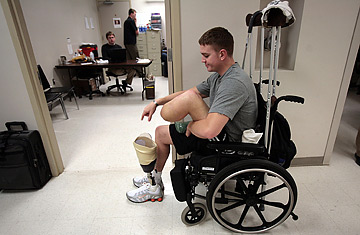
US Army soldier Daniel Alderman, a single amputee, tries on his prosthetic limb in the adjustment clinic at Walter Reed Army Medical Center in Washington, DC, December 2006.
But it was a courtesy that apparently stopped at the hospital's front door. According to a series in this week's Washington Post, some wounded soldiers have lived amid mice, mold and mismanagement in outpatient facilities. It was a shocking account to ordinary Americans who know of Walter Reed by its spit-shine, high-tech image, but especially to me. An embedded reporter who lost a hand in a grenade attack, I was treated at Walter Reed as an in-patient from December 16, 2003 to January 8, 2004, when I left for my home in Washington. I returned regularly to the hospital as an outpatient for 18 months, stopping often to visit friends who were living in the modern, clean Malogne House.
Even they grumbled about paperwork snafus and the bewildering medical retirement process. But they also enjoyed the freedom of outpatient life as well as comfortable housing and meals. Clearly problems worsened as the outpatient community exploded later in 2005. It was not until October of that year that soldiers were housed in the notorious Building 18.
Ironically, it is advances in medicine — not to mention an overabundance of bureaucracy as well — that created this war's unprecedented number of recovering outpatients. In past wars, injured soldiers were treated and discharged to VA hospitals for follow-up care. Walter Reed has kept them longer to improve use of the latest prostheses or ease post traumatic stress disorder and mild brain injuries, maladies rarely diagnosed in Vietnam.
Major General George W. Weightman, commander of Walter Reed, says another reason for the long tenure of outpatients — the average length of stay is almost 300 days — is that many wounded soldiers who had joined the volunteer army hope to stay in uniform. "We want to work with them as long as we can to get to that point of maximum medical benefit and give them the best chance of remaining on active duty," Weightman told me.
Walter Reed shouldn't be punished for extending its top-notch medical services to soldiers longer than military hospitals have in past conflicts. A leading center for amputations and brain injury, it has achieved amazing breakthroughs and revived function and hope for soldiers who would have died in past conflicts.
But as a top-notch hospital for soldiers wounded in the line of duty Walter Reed bridges two very different worlds — that of medicine and that of the military. It may seem harsh that recovering casualties have to assemble for formation at 5 a.m. But it is the army, after all.
Still, as a military institution, the hospital has a responsibility to war casualties even after they leave the wards, a sentiment Defense Secretary Robert Gates stressed on Friday while announcing that an indepenent panel would indeed investigate the problems at Walter Reed. The wounded fight a daily battle long after they returned from war. With national politicians finger-pointing and calling soldiers the victims of bad policy, Building 18 was a scandal waiting to happen.It's a shame Walter Reed has let it overshadow the extraordinary care it has provided a generation of warriors.
